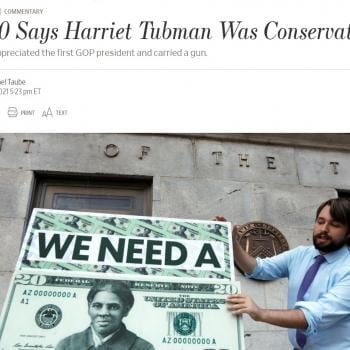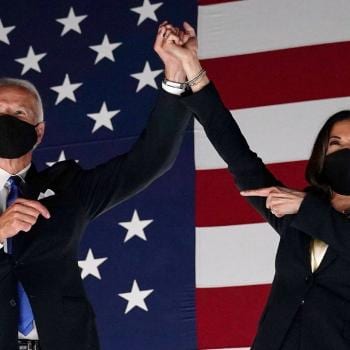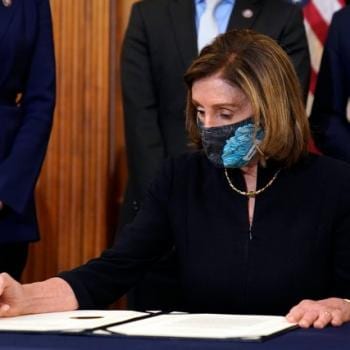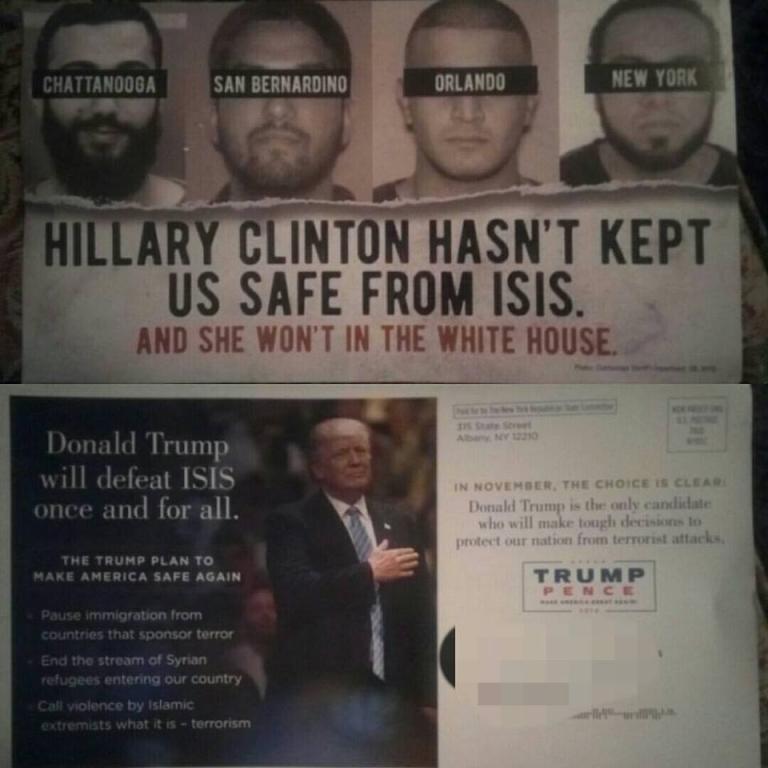
Image description: Under four male faces with words—Chattanooga, San Bernardino, Orlando, and New York—across their eyes are the words: “Hillary Clinton Hasn’t Kept Us Safe from ISIS. And She Won’t in the White House.” Next is a picture of Donald Trump with more text: “Donald Trump will defeat ISIS once and for all. The Trump Plan to Make America Safe Again. — Pause immigration from countries that sponsor terror. — End the stream of Syrian refugees entering our own country. — Call violence by Islamic extremists what it is—terrorism.” Additional text says “In November, the Choice Is Clear: Donald Trump is the only candidate who will make tough decisions to protect our nation from terrorist attacks.”
Who are the individuals pictured? In July 2015, Muhammad Youssef Abdulazeez killed five at two military centers in Chattanooga. In December 2015, Syed Rizwan Farook and Tashfeen Malik opened fire at a company Christmas party; fourteen were killed. In June 2016, Omar Mateen opened fire in a gay night club in Orlando, killing 49 before he was shot and killed by police. In September 2016, bombs went off in New Jersey and New York City; dozens ere injured, but there were no fatalities. Police arrested Ahmed Khan Rahami. According to the FBI, none of these individuals were directly connected to ISIS; all were motivated by foreign terrorist groups, and generally radicalized online. All four of these individuals were either born in the U.S. or immigrated to the U.S. as young children.
None of these cases occurred while Hillary Clinton held any elected or appointed government office. Trump’s argument appears to be that by not preventing the rise of ISIS (or otherwise ending global terror), Hillary allowed these attacks to happen. While Trump is welcome to take issue with Hillary’s tenure as Secretary of State from 2009 to 2013, I am more than skeptical of Trump’s claims that he can essentially snap his fingers and be rid of ISIS. Note what Trump is claiming—that he can defeat ISIS “once and for all.” That displays a fundamental lack of understanding of why groups like ISIS emerge and how they attract members. You can’t stamp these groups out with military alone—if you could, ISIS wouldn’t exist.
But there’s another problem here.
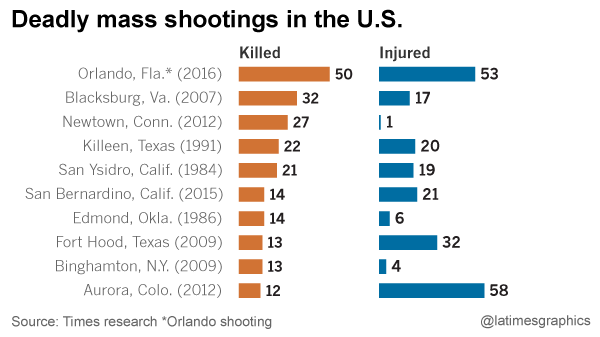
Based on this list, what are the most deadly shootings, after Orlando?
The 2007 shooting in Blacksburg, Virginia, is commonly known as the Virginia Tech shooting, carried out by a senior at that school. It was not related to terrorism. The shooting in Newtown, Connecticut, was the Sandy Hook Elementary shooting, in which an armed gunman killed first graders at an elementary school. Again not related to terrorism. The shooting in Killeen, Texas, was carried out by an armed gunman who ran his truck into a restaurant and then began shooting. Also not related to terrorism. The one in San Ysidro? In that case a man shot up a MacDonald’s restaurant. Again not related to terrorism.
Once we get in the 12-14 fatality range, in the image above, we come to the San Bernardino shooting, inspired by terror groups abroad, and the Fort Hood shooting, which the perpetrator stated was motivated by opposition to U.S. action in places like Afghanistan. But we also find the Edmond post office shooting, in which a man shot his coworkers at his place of work, and the Birmingham shootings, at which a naturalized Vietnamese immigrant man carried out a shooting at an immigration center where he had taken English lessons. We also get the Aurora shooting, at which a man shot into a crowded theater at the Batman premier.
Let’s talk about how we use the word terrorism. I wrote that the domestic mass shootings in the paragraph before last were “not related to terrorism.” Is this accurate? When we say “terrorism” we usually mean terrorism carried out in the name if Islam by groups like Al Qaeda, Boko Haram, and ISIS. Trump frequently claims that Hillary won’t say a specific sequence of words—“radical Islamic terrorists”—as though those words are a magic terrorism-ending formula. Regardless, our intelligence agencies are aware that such attacks today are typically inspired by foreign terrorist groups rather than directly orchestrated by them. Still, is it fair to restrict the label “terrorism” to these cases?
Merriam-Webster defines terrorism as “the use of violent acts to frighten the people in an area as a way of trying to achieve a political goal.” By this definition, a man who shoots his coworkers in a work-related dispute, like the Edmond post office shooting, is not a terrorist. A man who shoots women because he hates women, as in the case of the Killeen, Texas, shooting, is probably not a terrorist, although he might be. The shooter in San Isidro was an anti-government survivalist, but it is not evident that his belief in the coming breakdown of society played a direct role in his decision to shoot and kill 21 people at a local MacDonald’s restaurant. However, this ideology did play a direct role in Timothy McVeigh’s decision to bomb a government building in Oklahoma City in 1996, killing 169 people. And McVeigh was not an isolated case.
The Washington Post recently published an article titled ‘It will be a bloodbath’: Inside the Kansas militia plot to ignite a religious war. When I saw the headline, I had to wonder about the decision to use the “militia” label. Across the country there are hundreds of “militia” groups. Is this label fair? In the colonial period, militias were organized by the local government, not by private citizens. And we do still have a militia—it’s the national guard. These “militia” groups, then, are not actually militias. In some ways they’re similar to insurgent groups in other parts of the world—they’re opposed to the U.S. government and have organized to oppose it—except that they tend to be more about talk than action. Usually.
What was the Kansas “militia” plot?
The “Crusaders” knew they wanted to kill Muslims — and with luck, use the “bloodbath” to ignite a religious war — but for months they couldn’t settle on a plan.
The easiest way would be to grab guns, go to the predominantly Somali-Muslim apartment complex they’d been surveilling and start kicking in doors, court documents said. They would spare no one, not even babies.
In the end, they decided to set off bombs similar to the one Timothy McVeigh used in 1995 to kill 168 people in Oklahoma City. They planned to strike after the Nov. 8 election, investigators said.
By the time the group was shut down, they had already begun mixing the explosives they were going to use. The moment these “militia” groups decide to use violence to achieve their ends—and even groups that don’t often talk positively of such acts, or say that “someone” ought to do such things—they become terrorist groups.
We have a long-running domestic terrorist problem that has nothing to do with Islam. Sometimes it looks like Dylann Roof, who shot and killed nine African Americans in a church in North Carolina in 2015. Sometimes it looks like Wade Michael, who shot and killed six people in a Sikh temple in 2012. Sometimes it looks like Robert Dear, who killed three at a Colorado Springs Planned Parenthood in 2015. In fact, until the Orlando shooting earlier this year, right-wing extremists had killed more people in the U.S. since 2002 than had Islamic terrorists.
We also have a long-running mass shooting problem related to the ease of access to guns in the U.S. Sandy Hook, Aurora, Columbine, Virginia Tech—these shootings could not have happened if their perpetrators had not had access to guns. Increasingly, jihadists have been taking advantage of this ease. Note that both Orlando and San Bernardino both involved using guns to carry out a U.S.-style mass shooting. Our gun problem goes deeper, though. While shootings with fewer fatalities are less likely to make the news, they’re also far more common—domestic and work-related shootings chief among them.
Nearly ten times as many women are shot and killed by a domestic partner with a gun each year as died in the Orlando night club shooting. This is unheard of in the western world. And that’s not counting all the random shootings that happen when a man (and it usually is a man) goes on a rampage after shooting his family members, or, well—consider the man who shot and killed 10 at a college in Oregon because he was mad that women wouldn’t date him.
I am far more concerned about being killed by an armed white male upset at his ex-wife, or angry at the government, upset with his coworkers, than I am about being killed by Muslims inspired by terrorist groups abroad. And well I should be! Since 2002, 94 people have been killed in the U.S. by jihadists. During that same time, there have been over 200,000 murders in the U.S.
Donald Trump can take his mailing and stuff it. This sort of fear-mongering in an effort to stigmatize and deny help to Syrian immigrants—while simultaneously praising “the second amendment people” and opposing gun control—is disgusting.







